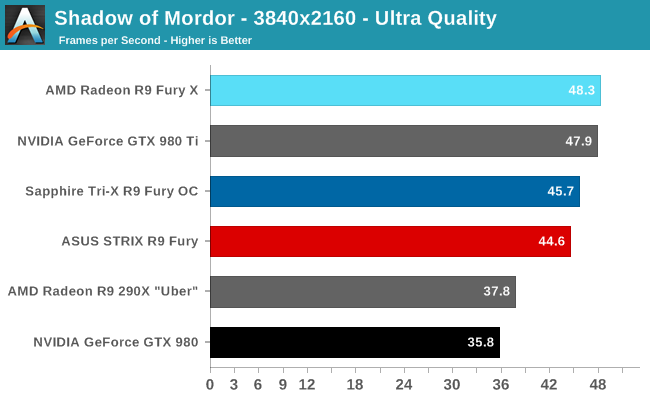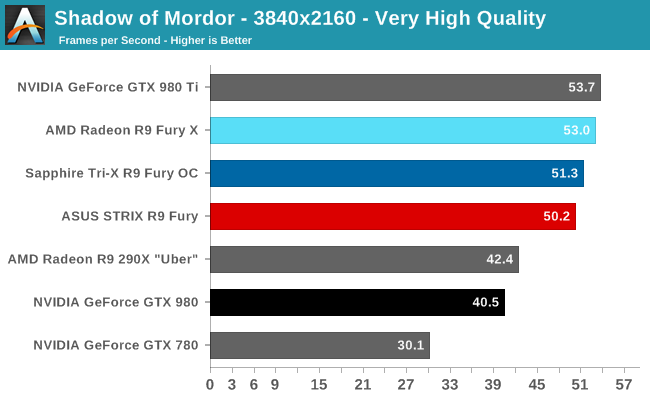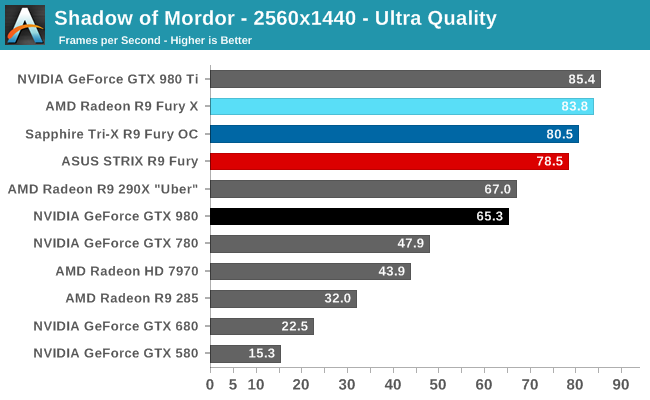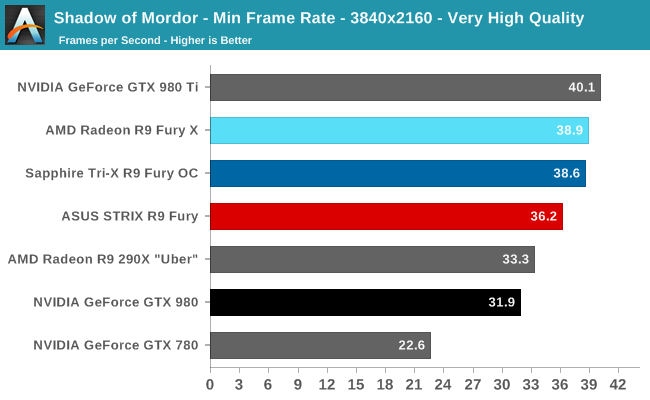The AMD Radeon R9 Fury Review, Feat. Sapphire & ASUS
by Ryan Smith on July 10, 2015 9:00 AM ESTMiddle Earth: Shadow of Mordor
Our next benchmark is Monolith’s popular open-world action game, Middle Earth: Shadow of Mordor. One of our current-gen console multiplatform titles, Shadow of Mordor is plenty punishing on its own, and at Ultra settings it absolutely devours VRAM, showcasing the knock-on effect that current-gen consoles have on VRAM requirements.



Shadow of Mordor ends up being a big win for AMD, with the R9 Fury cards shooting well past the GTX 980. Based on our earlier R9 Fury X review this was not an unexpected result, but at the end of the day with a 20%+ performance advantage, it’s a great situation for AMD to be in.
Meanwhile the R9 Fury’s performance relative to its X-rated sibling is yet again in the 7% range. So far the performance difference between the two cards is surprisingly consistent.
Finally, since AMD’s last two $550 cards were the R9 290X and HD 7970, let’s take a look at those comparisons quickly. At 1440p the R9 Fury only has a 17% lead over the R9 290X “Uber”, which for a card almost 2 years old is more than a bit surprising. The R9 Fury has more efficient front-ends and back-ends and significant advantages in shader throughput and memory bandwidth, and yet the performance gains compared to 290X are fairly small. On the other hand 7970 owners looking to upgrade to another Radeon should like what they’re seeing, as the R9 Fury’s 79% performance advantage is approaching upgrade territory.



Shifting gears to minimum framerates, the situation is similarly in AMD’s favor at 4K. One of the outcomes of going up against the GTX 980 is that it’s just as VRAM-limited as R9 Fury is, so in a VRAM intensive game like Shadow of Mordor, neither card has an advantage. However it’s quite interesting that once we back off to 1440p, the GTX 980 surges forward.










288 Comments
View All Comments
SolMiester - Saturday, July 11, 2015 - link
WOW, so much fail from AMD...might as well kiss their ass goodbye!Pimping the Fury at 4k, when really even the 980Ti is borderline on occasion, and releasing a card with no OC headroom at the same price as its competitor!
ES_Revenge - Saturday, July 11, 2015 - link
I didn't have too high hopes for the "regular" Fury [Pro] after the disappointing Fury X. However I have to say...this thing makes the Fury X look bad, plain and simple. With a pretty significant cut-down (numerically) in SPs and 32 fewer TMUs, you'd expect this thing to be more of a yawn. Instead it gives very near to Fury X performance and still faster than a GTX 980.The only problem with it is price. At $550 it still costs more than a GTX 980 and Fury has less OC potential. And at only $100 less than Fury X it's not really much of a deal considering the AIO/CLC with that is probably worth $60-80. So really you're only paying $30 or so for the performance increase of Fury X (which isn't that much but it's still faster). What I suggest AMD "needs to do" is price this thing near to where they have the 390X priced. Fury Pro at ~$400 price will pull sales from Nvidia's 980 so fast it's not funny. Accordingly the 390X should be priced lower as well.
But I guess AMD can't really afford to undercut Nvidia at the moment so they're screwed either way. Price is high, people aren't going to bother; lower the price and people will buy but then maybe they're just losing money.
But imagine buying one of these at $400ish, strapping on an Asetek AIO/CLC you might have lying around (perhaps with a Kraken bracket), and you have a tiny little card* with a LOT of GPU power and nice low temps, with performance like a Fury X. Well one can dream, right? lol
*What I don't understand is why Asus did a custom PCB to make the thing *longer*??? One of the coolest things about Fury is how small the card is. They just went and ruined that--they took it and turned it back into a 290X, the clowns. While the Sapphire one still straps on an insanely large cooler, at least if you remove it you're still left with the as-intended short card.
FlushedBubblyJock - Thursday, July 16, 2015 - link
can you even believe the 390x is at $429 and $469 and $479 ... the rebrand over 2.5 years old or so... i mean AMD has GONE NUTS.akamateau - Sunday, July 12, 2015 - link
@Ryan SmithHmmm.
You ran a whole suite of synthetic Benchmarks yet you completely ignored DX12 Starswarm and 3dMarks API Overhead test.
The question that I have is why did you omit DX12 benchmarks?
Starswarm is NOW COMPLETE AND MATURE.
It is also NOT synthetic but rather a full length game simulation; but you know this.
3dMark is synthetic but it is THE prime indicator of the CPU to GPU data pipeline performance.
They are also all we have right now to adequately judge the value of a $549 dollar AMD GPU vs a $649 nVidia GPU for new games coming up.
Since better than 50% of games released this Christmas will be DX12 don't you think that consumers have a right to know how well a high performance API will work with a dGPU card designed to run on both Mantle and DX12?
AMD did not position Fiji for DX11. This card IS designed for DX12 and Mantle.
So show us how well it does.
Ryan Smith - Monday, July 13, 2015 - link
The Star Swarm benchmark is, by design, a proof of concept. It is meant to showcase the benefits of DX12/Mantle as it applies to draw calls, not to compare the gaming performance of video cards.Furthermore the latest version is running a very old version of the engine that has seen many changes. We will not be able to include any Oxide engine games until Ashes of the Singularity (which looks really good, by the way) is out of beta.
Finally, the 3DMark API Overhead test is not supposed to be used to compare video cards from different vendors. From the technical guide: "The API Overhead feature test is not a general-purpose GPU benchmark, and it should not be used to compare graphics cards from different vendors."
FlushedBubblyJock - Thursday, July 16, 2015 - link
" Since better than 50% of games released this Christmas will be DX12 "I'LL BET YOU A GRAND THAT DOES NOT HAPPEN.
It's always the amd fanboy future, with the svengali ESP blabbed in for full on PR BS...
akamateau - Sunday, July 12, 2015 - link
@Ryan SmithDo you also realise that Fiji completely outclasses Maxwell and Tesla as well?
Gaming is a sideshow. AMD is positioning Fury x to sell for $350+ as a single unit silicon for HPC. With HBM on the package!!!
HPGPU computing is now up for grabs. Compaing the Fiji PACKAGE to the Maxwell or Tesla PACKAGE has AMD thoroughly outclassing the Professional Workstation and HPC silicon.
HBM stacked memory can be configured as cache and still feed GDDR5 RAM for multiple monitors.
AMD has several patents for just that while using HBM stacked memory.
I think that AMD is quietly positioning Fiji and Greenland next for High Performance Computing.
Fury X2 with 17 Tflps of single precision and almost 8Tflops dual precison is going to change the cluster server market.
Of course Fury X2 will rock this Christmas.
What will be the release price? I think less than $999!!!
AMD has made a habit of being the grinch that stole nVidias Christmas.
Ryan Smith - Monday, July 13, 2015 - link
Note that Fiji is not expected to appear in any HPC systems. It has no ECC, minimal speed FP64, and only 4GB of VRAM. HPC users are generally after processors with large amounts of memory and ECC, and frequently FP64 as well.AMD's HPC product for this cycle is the FirePro S9170, a 32GB Hawaii card: http://www.amd.com/en-us/products/graphics/server/...
FlushedBubblyJock - Thursday, July 16, 2015 - link
ROFLMAO delusion after delusion...loguerto - Sunday, July 12, 2015 - link
Looking at what happened with the old generation AMD and nvidia gpus, i wouldn't be surprised if after a few driver updates the fiji will be so ahead of maxwell. AMD always improved it's old architectures with software updates while nvidia quite never did that, actually they downgrade their old gpus so that they can sell their next overpriced SoC.